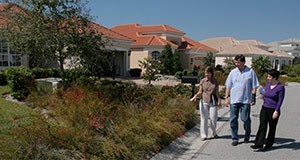Abstract
This 4-page fact sheet is the seventh publication in the Encouraging Landscape Water Conservation Behaviors series, which focuses on encouraging water conservation among Florida residents who use irrigation in their home landscapes. Extension educators create programs to encourage good irrigation practices and water conservation activities based on personal and social normative beliefs. To help in this goal, the authors examine personal and social norms of Florida residents who use irrigation in the home landscape and describe how Extension educators can capitalize on these positive norms to motivate Floridians to learn and use best water conservation practices. Written by Anil Kumar Chaudhary, Laura A. Warner, Alexa Lamm, Joy N. Rumble, and Randal Cantrell, and published by the Agricultural Education and Communication Department, September 2015.
References
Ajzen, I. (1991). The theory of planned behavior. Organizational Behavior and Human Decision Processes, 50(2), 179-211. https://doi.org/10.1016/0749-5978(91)90020-T
Blaine, T. W., Clayton, S., Robbins, P., & Grewal, P. S. (2012). Homeowner attitudes and practices towards residential landscape management in Ohio, USA. Environmental Management, 50(2), 257-271. https://doi.org/10.1007/s00267-012-9874-x
Clayton, S. (2007). Domesticated nature: Motivations for gardening and perceptions of environmental impact. Journal of Environmental Psychology, 27(3), 215-224. https://doi.org/10.1016/j.jenvp.2007.06.001
Gouldthorpe, J. L. & Israel, G. D. (2013). The Savvy Survey #3: Successful Sampling (AEC 393). Gainesville: University of Florida Institute of Food and Agriculture Sciences. Retrieved from http://edis.ifas.ufl.edu/pdffiles/PD/PD06300.pdf https://doi.org/10.32473/edis-pd063-2013
Haines, MP & Barker, GP (2003). The NIU Experiment: A Case Study of the Social Norms Approach. Chapter 2 in HW Perkins (Ed). The Social Norms Approach to Preventing School and College Age Substance Abuse: A Handbook for Educators, Counselors, Clinicians. San Francisco, Jossey-Bass.
Kumar Chaudhary, A. & Warner, L. A. (2015). Promoting behavior change using social norms: Applying a community based social marketing tool to extension programming. Journal of Extension, 53(3), 3TOT4.
Linkenbach, J & Perkins, HW (2003A). Most of Us Are Tobacco Free: An Eight-Month Social Norms Campaign Reducing Youth Initiation of Smoking in Montana. Chapter 13 in HW Perkins (Ed). The Social Norms Approach to Preventing School and College Age Substance Abuse: A Handbook for Educators, Counselors, Clinicians. San Francisco, Jossey-Bass
Sanagorski, L. A. & Monaghan, P. F. (2014). Using social norms to increase behavior change in sustainable landscaping (AEC494). Gainesville: University of Florida Institute of Food and Agricultural Sciences. Retrieved from http://edis.ifas.ufl.edu/pdffiles/WC/WC15800.pdf https://doi.org/10.32473/edis-wc158-2014
Schultz, P. W., Nolan, J. M., Cialdini, R. B., Goldstein, N. J., & Griskevicius, V. (2007). The constructive, destructive, and reconstructive power of social norms. Psychological Science, 18(5), 429-434. https://doi.org/10.1111/j.1467-9280.2007.01917.x

